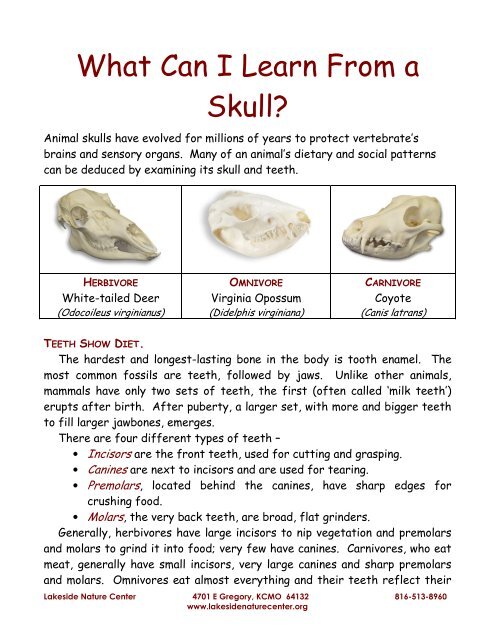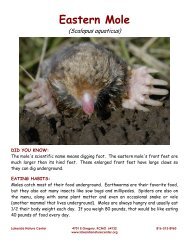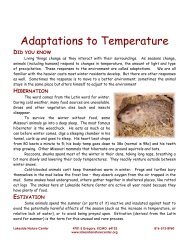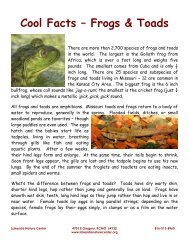What Can I Learn From a Skull? - Lakeside Nature Center
What Can I Learn From a Skull? - Lakeside Nature Center
What Can I Learn From a Skull? - Lakeside Nature Center
Create successful ePaper yourself
Turn your PDF publications into a flip-book with our unique Google optimized e-Paper software.
<strong>What</strong> <strong>Can</strong> I <strong>Learn</strong> <strong>From</strong> a<strong>Skull</strong>?Animal skulls have evolved for millions of years to protect vertebrate’sbrains and sensory organs. Many of an animal’s dietary and social patternscan be deduced by examining its skull and teeth.HERBIVOREWhite-tailed Deer(Odocoileus virginianus)OMNIVOREVirginia Opossum(Didelphis virginiana)CARNIVORECoyote(<strong>Can</strong>is latrans)TEETH SHOW DIET.The hardest and longest-lasting bone in the body is tooth enamel. Themost common fossils are teeth, followed by jaws. Unlike other animals,mammals have only two sets of teeth, the first (often called ‘milk teeth’)erupts after birth. After puberty, a larger set, with more and bigger teethto fill larger jawbones, emerges.There are four different types of teeth –• Incisors are the front teeth, used for cutting and grasping.• <strong>Can</strong>ines are next to incisors and are used for tearing.• Premolars, located behind the canines, have sharp edges forcrushing food.• Molars, the very back teeth, are broad, flat grinders.Generally, herbivores have large incisors to nip vegetation and premolarsand molars to grind it into food; very few have canines. Carnivores, who eatmeat, generally have small incisors, very large canines and sharp premolarsand molars. Omnivores eat almost everything and their teeth reflect their<strong>Lakeside</strong> <strong>Nature</strong> <strong>Center</strong> 4701 E Gregory, KCMO 64132 816-513-8960www.lakesidenaturecenter.org
preferences; they have all four types of teeth. In fact, if you’d like to seean excellent example of an omnivore’s teeth, look in the mirror.EYE PLACEMENT IDENTIFIES PREDATORS.Carnivores generally have large eyes, placed so that the eyes look forwardand the areas of vision of the two eyes overlap. This means that they havebinocular vision and they see objects with both eyes at the same time. Thisgives good depth perception.On the other hand, herbivores have eyes that face to the side, givingthem monocular vision; an object is seen with only one eye at a time. Whileherbivores lack depth perception, they can watch for approaching predatorsin all directions. Some speedy herbivores, like deer, have eyes that overlapslightly. This provides limited depth perception so they don’t run into treesas they flee from danger.Omnivores generally have eyes facing mainly to the front. This givesthem partly binocular vision and helps them in their search for a wide varietyof food.WHAT ABOUT NOSES?The area in front of the eye orbits, called the rostrum, houses the senseof smell. A large rostrum suggests that the animal hunts through scents oruses its nose to probe the ground or flowers. A deer’s long nose allows himto scan for predators while grazing. Coyotes hunt by scent and their longnoses contain millions of scent receptors. Cats (like the bobcat) hunt bysight and have short noses.HOW ABOUT HEARING?Two pea-shaped structures, called the auditory bulba, house the mammalsinner ear. The larger these nodes are, the better the animal’s sense ofhearing.WHAT DO JAWBONES TELL US?Like teeth, jawbones help identify a mammal as carnivore, herbivore oromnivore. Carnivore jaws are attached so that they only open and close; theteeth can not move from side to side. In contrast, herbivore jaws arefastened loosely; this side-to-side motion allows the animal to grind plantmaterial with his molars. Omnivore jaws are more like carnivore jawsbecause, in general, omnivores eat fruit and seeds not grass and branches.<strong>Lakeside</strong> <strong>Nature</strong> <strong>Center</strong> 4701 E Gregory, KCMO 64132 816-513-8960www.lakesidenaturecenter.org





